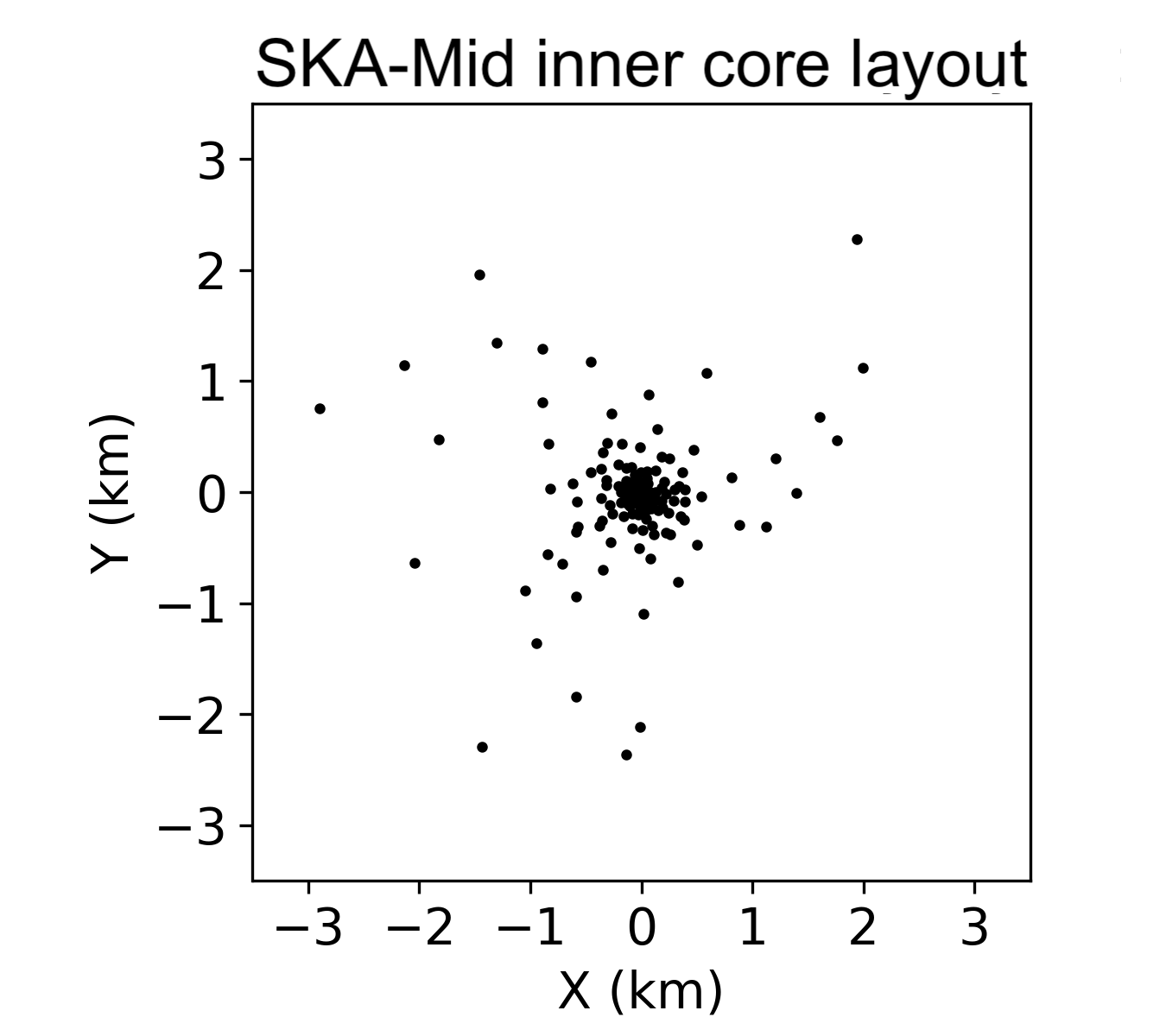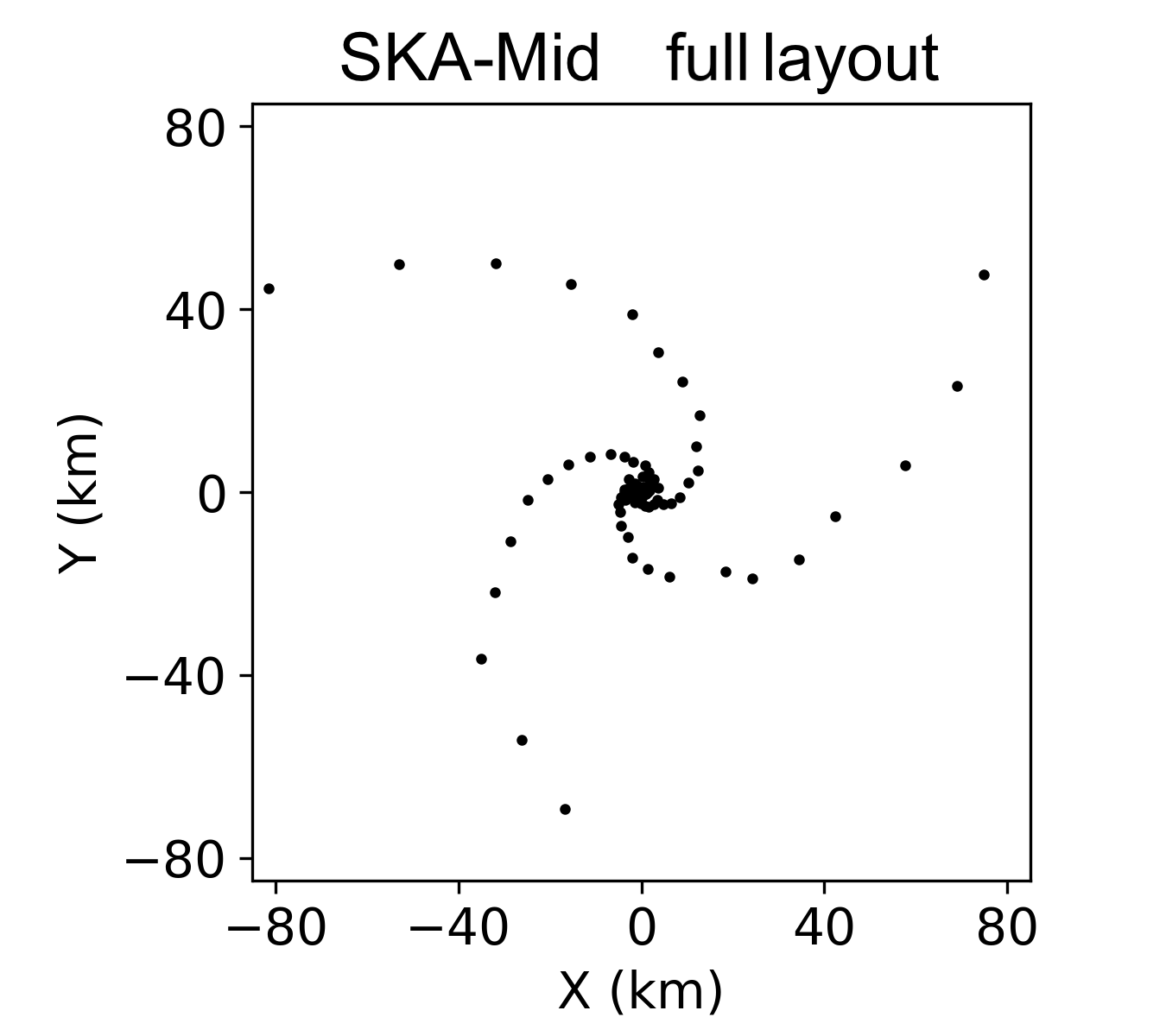SKA Telescope Specifications
The SKA design
The SKA in its first phase will consist of two telescopes: SKA-Low and SKA-Mid.
SKA-Low will cover the frequencies 50-350 MHz, using log-periodic dipole antennas grouped into stations (aperture arrays), and SKA-Mid will cover 0.35-15.4 GHz, using offset Gregorian dishes.
Each telescope consists of a dense core of ~1-2 km in size containing ~50% of stations/dishes, with the remaining receptors placed logarithmically along 3 spiral arms. The dense core provides excellent sensitivity to extended regions of low brightness and for pulsar and transient observations, while the 3-arm spiral provides a scale-free distribution of baselines, and so uniform sensitivity over a range of angular scales and excellent (u,v) coverage. The station/dish locations are fixed and so are not re-configurable.
The details of the overall system design of the SKA telescopes is captured in the Design Baseline Description, while the required science performance is captured in the Level 0 Science Requirements.
Further details, including projected performance, telescope roll-out and observing milestones, and tools for observation planning, can be found on the Documents, Scientific Timeline, and Tools webpages respectively.
Array Layouts
SKA-Low
SKA-Low will consist of 131,072 log-periodic dipole antennas distributed across 512 aperture array stations of 256 antennas each. It will be located in the Murchison radio-Astronomy Observatory (Inyarrimanha Ilgari Bundara), Western Australia. Around 50% of the stations will be located within a 1 km diameter core, with the remaining stations organised in clusters of 6 stations spaced logarithmically on three spiral arms. The maximum baseline length will be around 75 km.



SKA-Mid
SKA-Mid will consist of 133 15-m SKA dishes and 64 13.5-m Meerkat dishes at the Karoo Radio Astronomy Reserve in the Northern Cape of South Africa. The core will be composed of around 50% of the dishes, randomly distributed within 2 km. The remaining dishes are spaced logarithmically on three spiral arms providing baselines out to 150 km.



Frequency Bands
SKA-Low has a single frequency band, while SKA-Mid initially has 4 frequency bands deployed ("first generation", Bands 1, 2, 5a, 5b). For SKA-Mid, Bands 3 and 4 are part of the Design Baseline, but won't be deployed until funding becomes available.
| Telescope | Band | Frequency Range (MHz) | Available Bandwidth (MHz) | Notes (MHz) |
|---|---|---|---|---|
| SKA1-Low | N/A | 50 - 350 | 300 | (1) |
| SKA1-Mid | 1 | 350 - 1050 | 700 | (1) |
| 2 | 950 - 1760 | 810 | (1) | |
| 3 | 1650 - 3050 | 1400 | (2) | |
| 4 | 2800 - 5180 | 2380 | (2) | |
| 5a | 4600 - 8500 | 3900 | (1) | |
| 5b | 8300 - 15400 | 2 x 2500 | (1) |
Footnotes: (1) Deployed as a first generation receiver: (2) Deployed when funding become available.
Further, SKA-Mid is designed to work up to frequencies of 20 GHz, with a requirement on aperture efficiency at that frequency. The actual performance of the Mid dishes at 20 GHz remains to be determined (surface, pointing). If the dishes perform as expected, then a potential upgrade is the deployment of a frequency band for frequencies > 15 GHz is possible ("Band 6"), as part of a future Observatory Development Programme. The initial science case for observations at > 15 GHz can be found here. The useful highest operating frequency is still to be determined.
SKA anticipated science performance
The anticipated performance of SKA is captured in the plots below of sensitivity and survey speed as a function of frequency, compared with existing radio telescopes. Details can be found in the Anticipated Science Performance paper (undergoing revision - October 2024). The anticipated performance can also be explored via the SKA Tools.


The full SKA vision
While the current focus is to deliver the SKA phase 1 (SKA1) as per the design baseline described above and in the linked documents, the SKAO keeps the vision of a much larger SKA alive. Such vision is sometimes referred to as SKA2 (i.e. the second phase of the SKA project), consisting in increasing both the number of receptors (stations/dishes) and baseline lengths for each telescope (extending to other African countries in the case of SKA-Mid), and perhaps the addition of other telescopes (survey dish array, mid-frequency aperture array). This major expansion is in addition to upgrades envisioned as part of the Observatory Development Program, which will primarily be aimed at improving the performance of the as-built SKA phase 1.
While the actual scope of SKA2 is not fully defined the expansion may result in:
- 4-10 x SKA1 sensitivity in the frequency range of 50 – 350 MHz
- 10 x SKA1 sensitivity in the frequency range of 350 MHz – 15 GHz (including full frequency coverage)
- 20 x SKA1 Field-of-View in the frequency range of 350 MHz – 1.5 GHz
- Increased Field-of-View at frequencies > 1.5 GHz
- Increase in the high frequency range of SKA-Mid to 25 GHz or higher
- 20 x SKA1 maximum angular resolution




